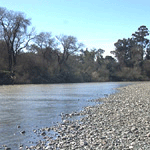


Published on September 18, 2002 © 2002- The Press Democrat
THE RIVER'S ONLY CONSTANT IS CHANGE
BYLINE: Chris Coursey
| Even if you don't swim in it, fish in it, paddle in it or even see your reflection in it, the Russian River runs through your life. Its water is the reason humans came here in the first place, and is what allows us to remain here now. The river sustains us. Yet, unless we are swimmers, fishers or paddlers, most of us spend little time reflecting on the river. We know it's there, but like the air, we take it for granted. We shouldn't. A video history of the river will be shown at 6 p.m. Thursday at the Sonoma County Museum, part of this week's Russian River Watershed Celebration. Produced by Santa Rosa's Nolte Media, it portrays the river as a living thing, constantly in motion, constantly in flux. Old-timers remember when the river would dry up in the summer, leaving long stretches of muddy riverbed between Healdsburg and Ukiah. A distant memory. But history has a way of repeating itself on the river. Grapes gave way to hops that gave way to grapes again; dry years can make a comeback, too. Look north this month to Lake Mendocino, the man-made reservoir created in 1959 in part to bring an end to those dry summers. This year the lake is more like a puddle, because while plenty of water is being released to sustain river flows in northern Sonoma County, very little water is coming in. The problem at Lake Mendocino is happening because, despite man's best efforts to control it, nature isn't behaving the way we'd like it to. Last winter was a technically ``dry'' season in the Eel River Basin, meaning less water is being diverted this year from the Eel into the Russian. But the Russian River Basin experienced a ``normal'' winter, allowing Sonoma County to suck a ``normal'' amount of water out of Lake Mendocino, even though that reservoir has less than its ``normal'' level of water. The result is a water system that, while still controlled by engineers, is more like it was before technology took over. It's getting awfully dry at the end of the summer. In other words, normal. |
Normal along the Russian River has meant a lot of things over the millennia. In the historical video, archaeologist Breck Parkman says the area 14,000 years ago resembled the Serengeti Plain of Africa, with lions and saber-tooth tigers roaming what now are vineyards and mall parking lots. Otis Parrish traces the history of his ancestors back 8,000 years, a time when as many as 80 bands of Pomos lived off what the river offered them. The Russians came for seals in 1812, followed by the Spanish. The Americans were relative latecomers, but once they came they arrived in droves (a habit we haven't kicked). But even the ``civilized'' river was a wild place. Marion McMurtrey on the video describes her ancestor Louis William Ridenhour's demise as caused by ``having his belly ripped out by a grizzly'' along the river. As always, though, the river changed. ``The most voluminous body of living vegetable matter ever to grow on Earth'' -- the redwood groves around Guerneville -- was logged out by 1900. The heyday of the summer resorts -- with music by Harry James and Glenn Miller -- came and went. The lower river became a year-round community. Today, the river supplies more than a half-million of us with water. Without it, our temporary settlements would wither.  Which is why it's important to hear the parable that Parrish tells at the end of the video. He says the Creator in the beginning set up rules so the humans and the plants and the animals could live in harmony. ``Don't pick all the huckleberries off the huckleberry bush,'' the Creator tells the humans. ``Save some for the bear; save some for the bush.'' The river is our huckleberry. |
